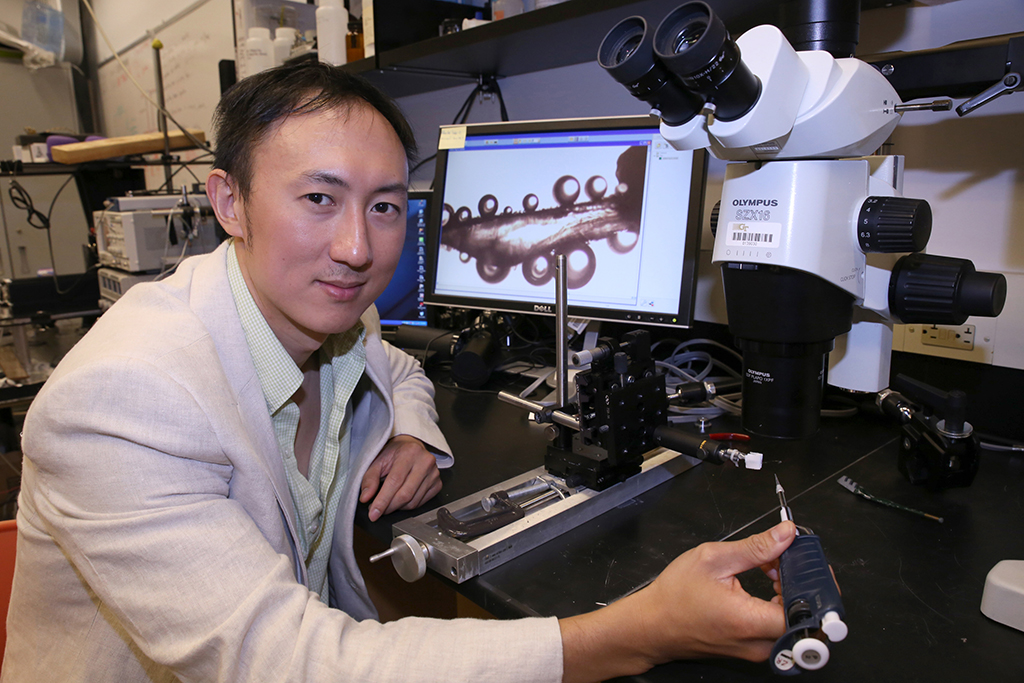David Hu
Have you ever wondered how flying insects survive in the rain? With a weight approximately 50 times that of a mosquito, a raindrop has a considerable force in comparison, similar in ratio to a Volkswagen Beetle falling on a human being. So why don’t insects get crushed by rain?
This is a question that David Hu (SB ’01, PhD ‘06), a professor of mechanical engineering and biology at Georgia Institute of Technology, asked himself a few summers ago as he sat on his porch watching a rainstorm.
It wasn’t an unusual question for Professor Hu to be asking. A 2-A student as an undergrad in MechE, he got hooked on fluid mechanics after taking a course with Professor Gareth McKinley. “I always wanted ways to teach people fluid mechanics – and I think there is no better way to learn fluid mechanics than to mix it with some biology. Zoos, zoo animals, zoology – they have no problems attracting crowds from all sorts of ages and disciplines. It’s just fun.”
He discovered that the force of raindrops on insects is greatly influenced by their respective mass, based on the concept of conservation of momentum. When a raindrop hits a dragonfly, the dragonfly is so massive that there is a high impact force that causes the raindrop to lose about 98% of its speed. But when it hits something as lightweight as a mosquito, the raindrop actually moves with the mosquito so that it loses only about 5% of its original speed and applies very little force to the mosquito.
“There’s a lot of interest in this because there are a lot of people that can build really small devices now,” says Professor Hu. “Studying how insects work in these dangerous environments is now becoming more important because we can actually build things to emulate what insects do.”
When Richard Larson – the Mitsui Professor of Engineering Systems and Director of the Center for Engineering Systems Fundamentals at MIT – read Professor Hu’s article in the New York Times about how mosquitos fly through raindrops, he recognized its potential to teach kids about science and engineering. Professor Larson is the co-founder and principal investigator of the MIT BLOSSOMS Initiative (our own Professor Dan Frey is a co-principal investigator). BLOSSOMS is a series of free interactive video modules taught by “guest teachers” meant to supplement a high school teacher’s standard curriculum. Each video is designed for viewing in brief segments, allowing the in-class teacher to engage the students in an active, goal-oriented exercise between segments. (To see an MIT BLOSSOMS video in action, watch teacher John Bookston’s statistics class at Arlington High School in Arlington, Mass.)
Professor Larson invited Professor Hu to record himself teaching his mosquito-in-the-rain research for high school students. He thought it would be a great way of achieving the multi-state Next Generation Science Standards (NGSS), which are requiring an interdisciplinary approach to high school education.
“It’s not easy to boil down university research to a high-school level,” says Professor Hu, “but the question of how mosquitos fly in the rain is a great problem because it makes people think about mechanics and surfaces. It also teaches kids to think about the importance of scale. It combines some biology with some math, and some engineering with a bit of robotics. If a mosquito gets hit by a raindrop, it really is a very different thing than if you or a car gets hit by a raindrop. As we have shown in the video, raindrops don’t break when they hit mosquitoes. The two just fall together. All of these things combine, and I think it’s just great for [high school] students.”
BLOSSOMS isn’t the first time Professor Hu has worked on a project geared toward students. In fact, as a matter of course he does one every couple of years. Two years prior to his mosquito video, he did a video on the frequencies dog shake at to dry. He filmed 35 different animals and discovered what he and his grad student coined “the wet-dog shake rule” – the frequency at which animals need to shake to dry. It was such an interesting question that their findings were featured on Good Morning America.






